汽车专业英语2
- 格式:doc
- 大小:39.00 KB
- 文档页数:2
![汽车专业英语(第二版)[111页]](https://uimg.taocdn.com/79b645a1ed630b1c59eeb5ef.webp)
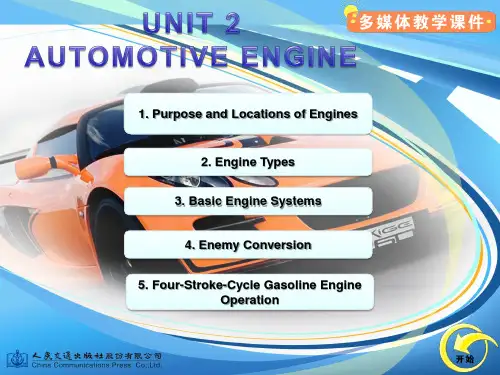
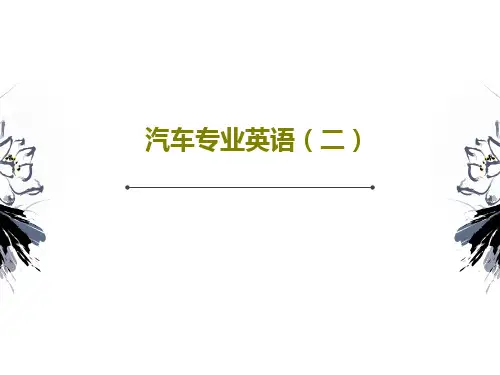
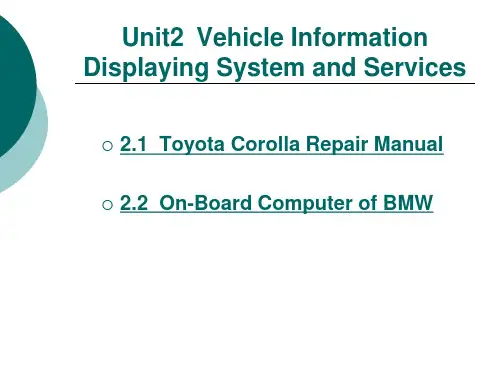
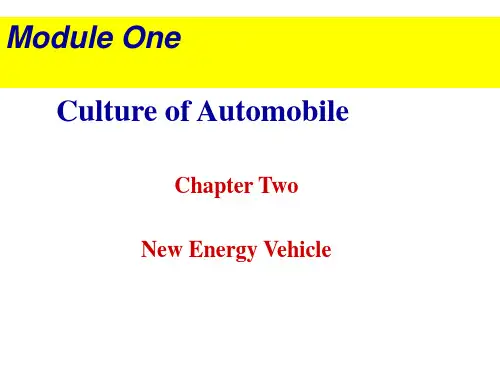
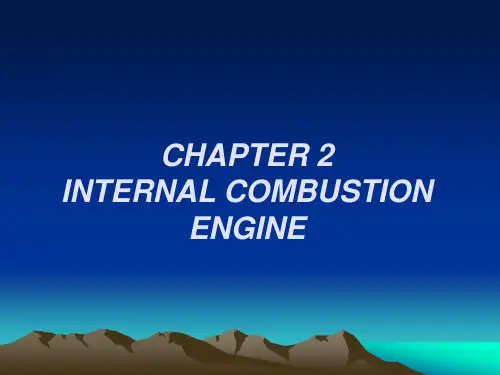
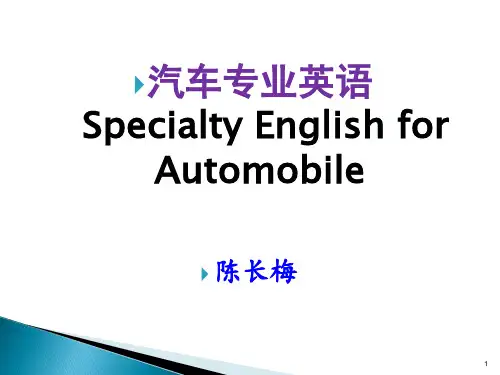
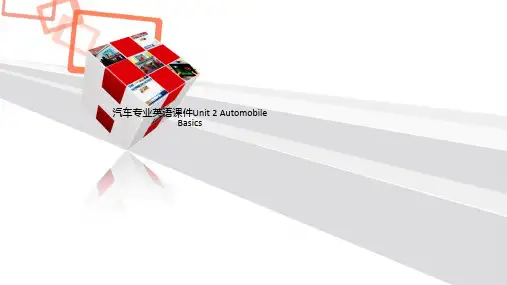
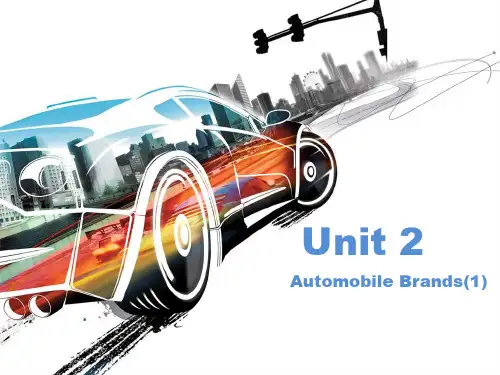
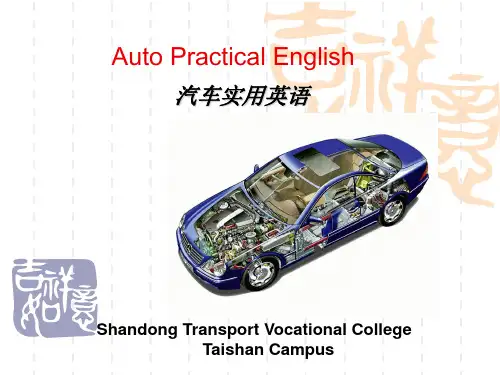

第1章一般信息1.1汽车的基本组成今天的一般汽车有15000多个必须相互配合才能工作的单个零件。
这些零件可分为四类:发动机、车身、底盘和电气设备,见图1-1.图1-1 汽车的基本组成发动机用作动力装置,有两种类型:汽油机(也叫做点燃式发动机)和柴油机(也叫做压燃式发动机)。
所有的发动机都有燃料供给系统、排气系统、冷却系统和润滑系统。
汽油机还有点火系统。
点火系统的作用是提供点燃缸内空气-燃油混合气所需要的电火花。
燃料供给系统的作用是存储液态燃料并将其供入发动机。
在化油器内,在进气歧管内或者在气缸内,燃料与空气混合,从而形成可燃混合气。
冷却系统的作用是从发动机上除去多余的热量。
利用空气和冷却液将热量带走。
润滑系统对于保持发动机平稳运转非常重要。
发动机油是润滑系统使用的润滑剂。
1.1.1 车身汽车车身(图1-2)对发动机、乘客和货物起保护作用。
车身的设计应保持乘客安全而舒适。
车身的造型应为车辆一个极具吸引力、鲜艳的、时髦的外表。
车身被制成流线型,以便减小空气阻力,并防止高速时汽车摆动。
图1-2 汽车车身1.1.3 底盘底盘包括传动系统、悬架系统、转向系统和制动系统。
传动系统包括离合器、变速器、传动轴、后桥与差速器以及驱动轮。
离合器或液力变矩器的任务是切断和连接发动机与汽车驱动轮之间的动力传递。
变速器的主要作用是在发动机与驱动轮之间提供一个传动比选择,从而使车辆在所有的行驶条件下都能够满意地工作。
档位的选择可以由驾驶员手动进行,或者靠液压系统自动选择。
传动轴的作用是将动力从变速器传递给后桥-差速器总成的输入轴。
柔性接头允许后桥和后轮上下运动,却不会影响工作。
后桥-差速器总成将发动机旋转动力的传递方向改变90度,从传动轴传到后桥,再到后轮。
它的另一个作用是让每个驱动轮以不同的转速转动。
第三个作用是引入一个传动比,对转矩进行放大。
悬架系统的基本作用是吸收路面凹凸不平所引起的冲击(否则的话,这些冲击将会传递给车辆及其乘客),因此,不管道路条件怎样恶劣,有助于将车辆保持在可控制的笔直的路线上。
UNIT TWO P18An automobile probably has about 7,000 different parts in it. Some of them make it more comfortable or better looking, but most of them are to make it run.一台车可能有7000多个不同的零件。
一些使它更舒适或外观更好看。
但大部分是使它能运转的。
The three basic components of the automobile are the engine, chassis and body.汽车基本三大组成部分是发动机,底盘和车身.The engine converts the fuel energy into mechanical power. An internal combustion engine powers our modern automobile. The engine burns its fuel within the engine proper, as compared to a steam engine where the fuel is burned externally. The gasoline and air mixture of the internal combustion engine is compressed by a piston inside an airtight cylinder and ignited by a spark. The trapped air-fuel mixture burns fiercely, causing tremendous heat which expands the trapped gases and pushes the piston down. This is the motive power of the automobile. The automobile engine is essentially a heat engine. It requires fuel to burn, a spark to ignite, lubrication to minimize friction, and a cooling system to dissipate unwanted heat.发动机把燃油的能量转化成机械能.内燃机给现代的汽车提供动力。
发动机在其内部燃烧油料,相比蒸汽机是在外部燃烧燃料。
内燃机汽油和空气的混合物通过密封汽缸内的活塞压缩,由火花塞点燃。
被密封的空气燃料混合物剧烈燃烧,产生很高的热量,使压缩气体膨胀并推动活塞下降。
这就是汽车的原动力。
汽车发动机实质上是个热能发动机。
它需要燃料燃烧,火花塞点燃,润滑剂减小摩擦,还要有冷却系统来驱散多余的热量。
The fuel system takes a correctly proportioned mixture of gasoline and air to burn and develop the power needed to push the piston down the cylinder. To store, mix, and deliver this air-fuel mixture is the duty of the fuel system.燃油系统吸取适量比例的汽油空气混合物进行燃烧并传递能量,推动汽缸向下运动.储存,混合和传递空气燃油混合物是燃油系统的工作.When the explosive mixture of air and gasoline is compressed tightly, a spark is sent through the mixture, setting it on fire, which results in the heat and expansion used to push the piston down the cylinder. The ignition system furnishes a spark to each spark plug when its cylinder is full of the compressed air-fuel mixture.当空气和汽油的爆炸性混合物被压紧,火花塞通过混合物,点燃气体。
产生的热量和膨胀力推动活塞在汽缸内下降。
当其内部充满空气燃油混合物时,燃油系统给每个火花塞提供火星.The lubrication system provides a constant flow of filtered oil to all moving parts of the engine. The system consists of an oil pan to store the oil, a pump to circulate it, a filter to remove solid abrasive particles, and an oil gauge or light in the driver’s compartment for checking purposes.润滑系统连续不断地给发动机所有运动部件提供过滤油脂.此系统包括储存油的油底壳,循环油的油泵,带走固体腐蚀颗粒的过滤器,以及在司机舱内用于测量的油压表或灯.The engine derives its power from burning fuel. Unfortunately, not all of this heat can be used, and, if allowed to remain in the engine, it would soon destroy it. The temperature of the burning air/fuel mixture About 4500°F. Compare this with the boiling point of water, 212°F, and the melting point of iron, 2500°F. If this unused heat were not removed, the engine would soon melt. 发动机的动力来自燃烧的燃油,然而不是所有的热量都被使用,而且如果让这些热量留在发动机内,它会很快损毁发动机的。
空气燃料混合物燃烧时温度达到约4500°F.与水的沸点212°F和钢铁的熔点2500°F相比,如果这些剩余的热量不被带走的话,发动机会很快熔化的.The coolant of the cooling system picks up the excess combustion heat as it is circulated throughthe block and heads by a centrifugal-type pump, delivered to the radiator where it is cooled, and then returned to the water pump for recirculation.冷却系统的冷却液由离心泵推动在缸体和缸盖间循环,带走多余的内燃热量。
传递给散热器冷却,然后回到水泵进行再循环。
The chassis comprises the drive line, running gear (undercarriage) and control mechanism.底盘由传动系,齿轮和控制装置组成。
The drive line consists of mechanisms and units which transmit torque from the engine to the drive wheels and change torque and rpm in magnitude and direction. Among these mechanisms and units are the clutch, transmission (gear box), propeller shaft, and final drive comprising differential and axle shaft.传动系由传递发动机扭距给驱动轮,并转换扭距和转速大小和方向的机构和单元组成。
这些机构和单元包含离合,变速箱,传动轴,主减速器包含差速器和桥轴.The clutch is a friction device used to connect and disconnect a driving force from a driven member. It is used in conjunction with an engine flywheel to provide smooth engagement and disengagement of the engine and manual transmission. Since an internal combustion engine develops little power or torque at low rpm, it must gain speed before it will move the vehicle. However, if a rapidly rotating engine is suddenly connected to the drive line of a stationary vehicle, a violent shock will result.离合器是个摩擦装置用于连接和解除其他传动装置的力矩.它用于连接发动机飞轮,使得发动机和手动变速箱可以自由连接和解除.由于内燃机发动机在低转速下产生很小的力量,所以在发动车辆的之前必须先加速.然而,如果一个快速运转的发动机突然连接到静止状态的传动系,必然会导致强烈的振动.A transmission is a speed and power changing device installed at some point between the engine and driving wheels of the vehicle. It provides a means for changing the ratio between engine rpm and driving wheel rpm to best meet each particular driving situation. It converts torque in magnitude and the direction, allows the automobile to move forth and back and the engine to be disconnected from the drive line for a longer period of time.变速箱是安装在发动机和驱动轮之间的速度和动力改变装置.它提供改变发动机和驱动轮转速比率拉一适应各种行使条件的方法。